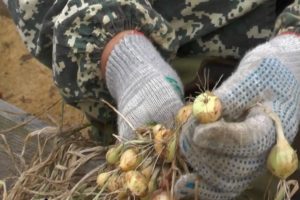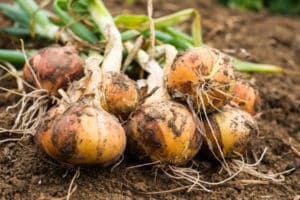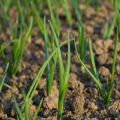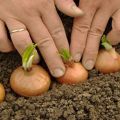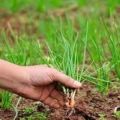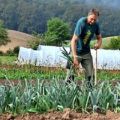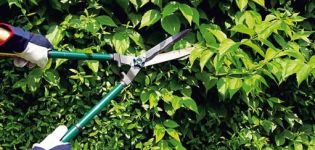How and where is it better to dry onions after harvesting from the garden
There are certain rules for how to dry onions after harvesting from the garden. This process largely affects the safety of the crop and its long-term storage. In order for the vegetable to dry well, dig it out, also following the recommendations.
When and how to remove onions from the beds?
To dry the onion well, it is recommended to follow the rules. For 14-15 days before the expected harvest, you need to stop watering the plants. At night, it is recommended to cover the plantings with a film from morning dew.
Onions are harvested around the end of July, beginning of August. A vegetable grown from seedlings begins to be harvested a little earlier than one that grew from seedlings. External signs will help determine the degree of maturity of the head. Feathers usually begin to turn yellow, dry out and creep along the ground, the neck becomes thinner, dries. The bulb has a characteristic golden yellow color, the husk is dry, rustles and easy to clean.
Dig the bulbs with a fork or shovel. At a short distance from the head, they dig in the ground and then pull it out with their hands. Pulling out the onion by hand can damage the base, leading to early decay.
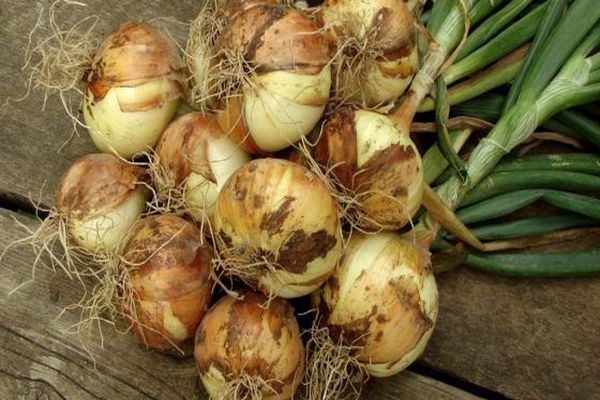
Harvesting is desirable on a warm, sunny, dry day. It is better to dry the vegetable in the sun rather than in the shade. The sun's rays and the wind dry well to the very center of the bulb, while disinfection occurs at the same time. First, you need to carefully shake off the adhering dirt from the heads, but do not beat them against each other. The bulbs are laid out in one layer, periodically turning over with different sides to the sun.
If it rains every day, then a few days before harvesting, you can cover the bed with foil. The harvested crop is immediately removed to a room with good ventilation.
Where and how to properly dry onions after harvesting?
High-quality drying of onions will preserve the taste and benefits for a long time. There are some differences in this process when it comes to sevka, onion or nigella.
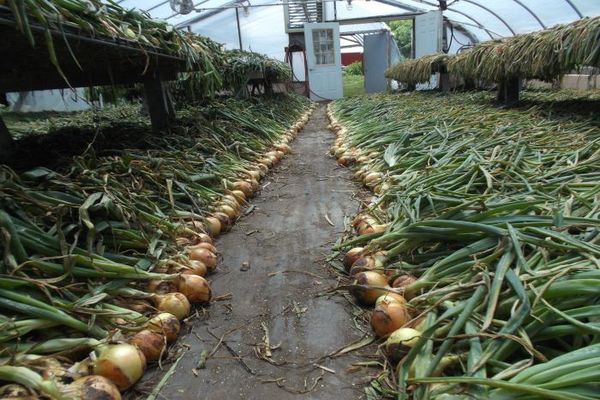
Sevok
Sevok is put away for storage in order to plant it next year. Dry onion sets for at least a month. The first week, if the weather permits, it is better to dry outside, on the floor with the rays of the sun. Periodically, the seedlings are stirred so that light and air come to each site. If the weather is damp, then spread the sevok on cloth or paper in a room with good circulation of fresh air.
When the neck is completely dry and golden, dry scales appear, you can harvest the crop in a storage container. Damaged and small bulbs are removed to the side. The size of the planting material should be approximately 2 cm in diameter.
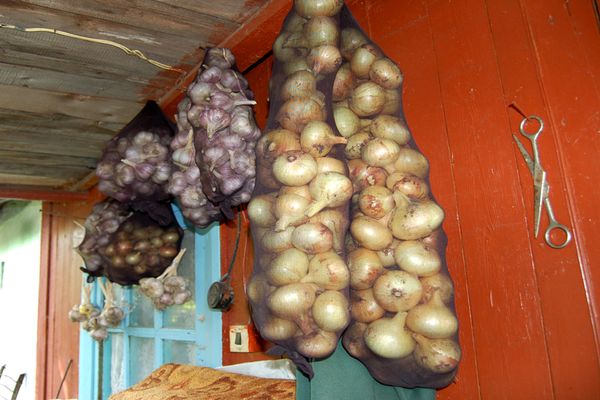
It is allowed to store in cardboard boxes, nets or fabric bags, hanging from the ceiling. Periodically, the bulbs are sorted out and suspicious heads are selected (the presence of spots, an unpleasant smell, softening of the head should be alerted). In order for the seed to have the ability to germinate after planting, it must be stored at a temperature of at least +16 degrees.
Sevok can also be stored cold. In this case, it is stored in a refrigerator or basement at a temperature of -2 degrees. Previously, the vegetable must be warmed up at a temperature of +30 degrees for two weeks. Before planting, the seedlings are warmed up again.
Onion
There are some peculiarities and how to properly dry onions after harvesting. Onions take two weeks to dry out. The first two days are left to dry in the garden, and then transferred to a dry, ventilated room, where the air temperature is about +25 degrees.
In well-dried onions, the neck becomes thinner, dries up, the head is covered with dense, rustling, golden scales. The bulbs are firm to the touch and smell good. Before putting them in a storage container, you need to cut off the feathers, leaving a stump of 3-4 cm. If you intend to weave braids from them, then leave a length of about 10 cm.
For storage, only whole, dense, without damage heads are selected, which can be laid out in boxes, boxes, baskets, nets. The crop is best stored in a dark, cool place with good ventilation.
How to dry nigella?
Onion seeds are called nigella and the better they are dried, the more likely it is that all the beneficial properties will be preserved. Vegetable growers advise to dry nigella in three stages using home heating devices:

- the first 7 days after the onion is kept indoors at a temperature of +20 degrees;
- another 7 days the vegetable is dried at +30 degrees;
- the whole third week, the bulbs are dried at +35 degrees.
After drying, the nigella is laid out in boxes or bags and put away in a cool place. The air temperature should not exceed +18 degrees. Do not forget to review the harvested crop, picking rotten bulbs on time.
How to dry onions for the winter at home?
There are many ways to dry onions at home using household appliances or outdoors. Before drying, the turnip is cut into slices. The thickness of the cut should be about 4–5 mm, otherwise it will not dry out. Chopped onion pieces dried for storage are poured into containers (cans, boxes, boxes are suitable) and put away in a cool place.
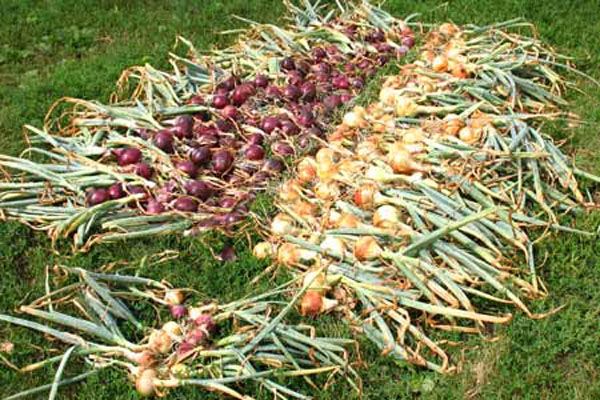
In the oven
A good way to dry onions after harvest is using the oven. Cover the baking sheet with baking paper and lay out the cut rings in one layer. The oven is heated to 60 degrees and a sliced baking sheet is placed in it. The oven door does not need to be closed. The drying procedure takes approximately 6 hours. All this time, onion rings are periodically turned over so that they do not darken and burn.
As soon as the rings are completely dry, the cooled product is transferred to linen bags, cardboard boxes or a glass jar. The main thing is that air does not penetrate into the container. It is better not to close the container for the first days, the dry slices will dry out completely at this time. Only after that, the containers are closed and stored in a dry, dark, cool place.
In an electric dryer
Onions can be dried in an electric dryer. With this device, the product dries quickly without losing its beneficial qualities. The chopped onions are distributed on trays from the dryer, and then placed in the device for 7 hours at a temperature of 60 degrees. Once the slices are dry, they are moved into bags.
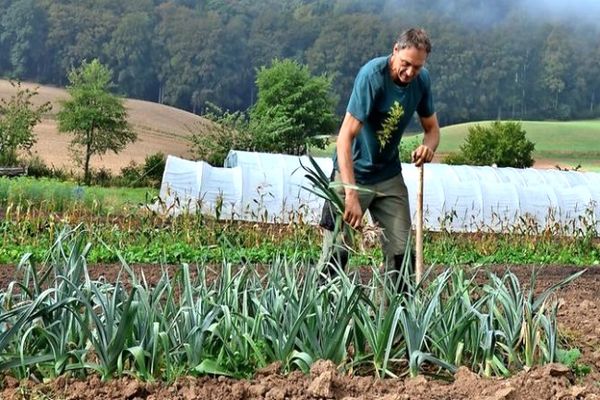
In the airfryer
You can cook any dish with the help of the airfryer. The hot air stream allows you to fry, stew, bake, smoke. There is another useful function - drying.Kitchen equipment can be used not only for drying onions, but also for mushrooms, fruits, berries, herbs. During drying, a beautiful appearance, pleasant taste and useful components are preserved.
The airfryer consists of a lid and a heat-resistant glass bowl. During operation, the spiral heats up, the air constantly circulates inside and as a result, the onion rings dry evenly.
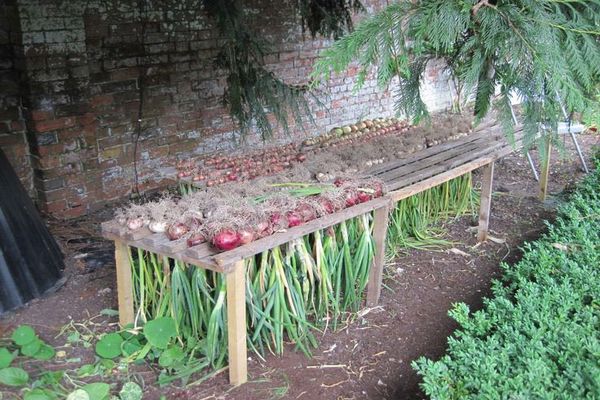
In an airfryer, onions can dry in just one hour at a temperature of about 70 degrees, but only when they were placed, not a whole onion, but chopped slices. In order for the rings to be well and efficiently dried, the lid must be kept slightly open.
On air
Onions, cut into small slices, can also be air dried in the shade. A spicy vegetable is laid out in a thin layer on any surface, for example, on cardboard. The rings are turned over daily to dry evenly. This drying method is suitable if the weather is dry and warm.
If the weather is good, then the onion can be dried as a whole by spreading it out in one layer on a fabric surface right outside. In case of cold, rainy weather, it can be removed to a well-ventilated area such as a barn or hayloft (it is better to keep the door ajar).
Experienced vegetable growers in their country house make special devices for drying onions with their own hands. If the barn is built in such a way that there is a canopy, you can strengthen the shelves from the blocks to its wall. Such bulbs will not get wet with rain, and air will flow to the vegetable around the clock.
